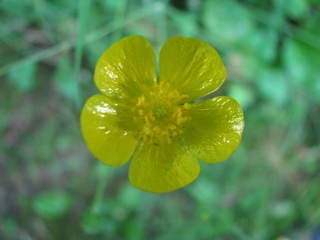Gmelin's buttercup
(Ranunculus gmelinii)

Description
Ranunculus gmelinii, Gmelin's buttercup or small yellow water-crowfoot, is a species of flowering plant in the buttercup family, Ranunculaceae. It is native to northern North America, where it occurs across Canada and the northern and higher-elevation regions of the United States. It is also present in Eurasia. This species is a perennial herb growing prostrate stems on moist ground or floating stems in shallow water. It is hairy to hairless. The leaf blades are round or kidney-shaped and are divided into three parts that may be subdivided. The yellow petals are 4 to 14 millimeters long. Ranunculus gmelinii occurs in wetland habitats and on shorelines. The plant is not a threatened species, but it becomes rare in the habitat on the edges of its range; it is protected as a threatened plant in the state of Maine, and var. hookeri is a state-listed endangered plant in Wisconsin. It is listed as an endangered species in Newfoundland and Labrador. This species was named in honor of Johann Georg Gmelin (1709-1755). Ranunculus is a large genus of about 600 species of flowering plants in the family Ranunculaceae. Members of the genus are known as buttercups, spearworts and water crowfoots. The familiar and widespread buttercup of gardens throughout Northern Europe (and introduced elsewhere) is the creeping buttercup Ranunculus repens, which has extremely tough and tenacious roots. Two other species are also widespread, the bulbous buttercup Ranunculus bulbosus and the much taller meadow buttercup Ranunculus acris. In ornamental gardens, all three are often regarded as weeds. Buttercups usually flower in the spring, but flowers may be found throughout the summer, especially where the plants are growing as opportunistic colonizers, as in the case of garden weeds. The water crowfoots (Ranunculus subgenus Batrachium), which grow in still or running water, are sometimes treated in a separate genus Batrachium (from Greek βάτραχος bátrakhos, "frog"). They have two different leaf types, thread-like leaves underwater and broader floating leaves. In some species, such as R. aquatilis, a third, intermediate leaf type occurs. Ranunculus species are used as food by the larvae of some Lepidoptera species including the Hebrew character and small angle shades. Some species are popular ornamental flowers in horticulture, with many cultivars selected for large and brightly coloured flowers.
Taxonomic tree:







